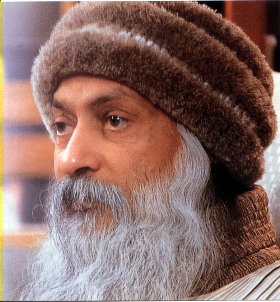If you wish to see the truth, then hold no opinion for or against.
Only those who are ready to become nobodies are able to love.
Remember one thing: meditation means awareness. Whatsoever you do with awareness is meditation. Action is not the question, but the quality that you bring to your action.
Liberation cannot be desired because desire is the bondage. When you are desireless, you are liberated.
Life
Realization: When he was 21 years old. He dropped all effort and hope. After an intense seven-day process he went out at night to the Bhanvartal garden in Jabalpur, where he sat under a tree where he became spiritually enlightened. It was 21 March 1953. He says: “The moment I entered the garden everything became luminous, it was all over the place – the benediction, the blessedness. I could see the trees for the first time – their green, their life, their very sap running. The whole garden was asleep, the trees were asleep. But I could see the whole garden alive, even the small grass leaves were so beautiful. I looked around. One tree was tremendously luminous – the maulshree tree. It attracted me, it pulled me towards itself. I had not chosen it, god himself has chosen it. I went to the tree, I sat under the tree. As I sat there things started settling. The whole universe became a benediction.”
Death: He Died on January 19, 1990 in Pune, India.
Teaching Style: A professor of Philosophy, he traveled throughout India as a public speaker. He advocated a more open attitude towards sexuality. His teachings have had a considerable impact on Western New Age thought. He taught as an individual consultations about spiritual development and daily life, in return for donations – a commonplace arrangement in India. He taught as answering questions sent in by visitors and disciples. He used Western psychotherapy as a means of preparing for meditation. He also introduced his own, “Active Meditation” techniques, characterized by alternating stages of physical activity and silence.
Fame: Osho was an Indian mystic, guru and philosopher. He advocated a more open attitude towards sexuality, a stance that earned him the sobriquet “sex guru” .In his discourses, he reinterpreted writings of religious traditions, mystics and philosophers from around the world. He was briefly associated with communism, socialism and two Indian independence movements, the Indian National Army and the Rashtriya Swayamsevak Sangh. He began to lead meditation camps, and the first meditation centers (Jivan Jagruti Kendras) started to emerge around his teaching, then known as the Life Awakening Movement (Jivan Jagruti Andolan). Over 650 books are credited to Osho, expressing his views on all facets of human existence.
Legacy: Until he was seven years old he live with his maternal grandparents . His grandmother gave him the utmost freedom, leaving him carefree without an imposed education or restrictions.At the age of this was a major influence on his development. At seven years old, his grandfather, whom he adored, died. He was profoundly affected by his grandfather’s death. He initiated disciples (known as neo – sannyasins) and took on the role of a spiritual teacher. He is widely regarded as one of the most significant philosophers and mystics of the 20th century. Osho counted, among figures such as Gautama Buddha and Mahatma Gandhi, among the ten people who had most changed India’s destiny by “liberating the minds of future generations from the shackles of religiosity and conformism”.
Teachings
His teaching as a whole was said to be nothing more than a “game” or a joke. His teachings were not static but changed in emphasis over time, forming an enormous body of work.
Osho’s syncretic teachings emphasis the importance of meditation, awareness, love, celebration, creativity and humor – qualities that in his view are suppressed by adherence to static belief systems, religious tradition and socialization.
His message was a positive one. He taught that we are all potential Buddhas, with the capacity for enlightenment. According to him, every human being is capable of experiencing unconditional love and of responding rather than reacting to life. He said: “You are truth. You are love. You are bliss. You are freedom. He suggested that it is possible to experience innate divinity and to be conscious of “who we really are”.
Our egos usually prevent us from enjoying this experience. When the ego is gone, the whole individuality arises in its crystal purity.
Osho views the mind first and foremost as a mechanism for survival.
We have been repressing anger, greed, sex … And that’s why every human being is stinking. … Let it become manure, … and you will have great flowers blossoming in you. Instead of repressing, we should accept ourselves unconditionally.
He says that by repeating the past, we lose the ability to live authentically in the present.
According to him meditation means awareness. Whatsoever you do with awareness is meditation. Meditation is not just a practice, but a state of awareness that can be maintained in every moment.
He mocks gods, prophets, scriptures and religious practices and gives a totally new dimension to religion.
For Him it is not the material world that needs to be renounced but our past and the conditionings and belief systems that each generation imposes on the next.
Religion is an art that shows how to enjoy life.


[…] Author: Sarlo Guru Rating Source: Guru Ratings Guru Rating by: Sarlo Guru: Osho […]
[…] Osho M 1931-1990 aka Bhagwan Shree Rajneesh, Rajneesh Chandra Mohan Jain […]